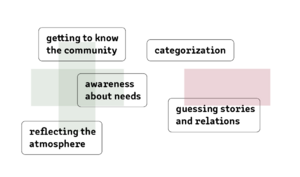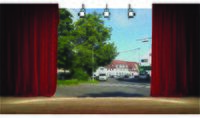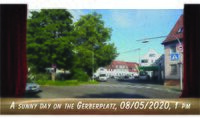LED2LEAP 2020 - Nuertingen Team 3: Difference between revisions
| Line 223: | Line 223: | ||
*''What happened, who was there and what was the atmosphere like among the participants?'' | *''What happened, who was there and what was the atmosphere like among the participants?'' | ||
<gallery caption=" " widths=" | <gallery caption=" " widths="200px" heights="150px" perrow="4"> | ||
File:The final realization process.jpg|The final realization process | File:The final realization process.jpg|The final realization process | ||
</gallery> | </gallery> | ||
Revision as of 15:31, 28 June 2020
>>>back to working groups overview
| Area | Klein-Tischardt | |
| Place | Nürtingen | |
| Country | Germany | |
| Topics | Strengthening diversity and preserving traditions | |
| Author(s) | Leila Hoffmann, Carolin Lenz, Chiara Marquart, Vanessa Thaser | |
Landscape Democracy Rationale
- Klein-Tischardt is a very mixed district. Different social groups live there in different forms of housing. We see a particularly high need for public open space there. People from different backgrounds and different age groups demand the exchange with other people. For this purpose (open) space must be created. The existing, currently undeveloped building area represents a fragile centre of democracy. In case of doubt, it is here that it can decide whether or not citizens are to be given a say. Moreover, the quarter is crossed by a main traffic axis. This means that more people than just the Klein-Tschardt residents have an interest, whether social or economic, in the design of the quarter.
Location and scope
- map editor
- District Klein-Tischardt, 72622 Nürtingen
Phase A: Mapping your Community
Welcome to your community and its landscape
- district Klein-Tischardt between the rivers Neckar & Steinach
- main road divides KT in two
- buildings with rural character
- unused squares & closeness to the river offers potential
- agricultural background
- high diversity
- high average age
Groups of actors and stakeholders in your community
- more visible groups: senior citizens,citizen’s initiative, families & children, students, refugees, city initiative
- less visible groups: rowers club, small businesses, workers, gastronomy, tourists
Relationships between your actors and groups
- senior citizens play a dominant role in the area
- refugees are less present and dominant
- shared interests: attractive open spaces, meeting points, safe road spaces, space for representation, possibility for interaction, leisure activities
Summary of your learnings from the transnational discussion panel on April 22
- the scale of the projects are completely different
- different approaches to analyse, get to know different methods
- very in-depth informations about the communities through the analysis
- highly appealing graphics, which supported the comprehensibility of the presentation
Theory reflection
- Lynch, Kevin. (1960): The Image of the City, Cambridge, Mass.: MIT Press
- the image of the city - is a way of making the city more readable and working with defined tools that’s a very practical method to work with a city and we think a recognisable district supports the identity and community
- we see it critically to categorize the community so strongly in groups, for our analysis and design the individuals are crucial
- storytelling is a very identity supporting and creating method, we like how intensively you deal with the community but we find it difficult to guess the stories without getting in touch with the community
References
- traffic space - public space from Stefan Bendiks and Aglaée Degros Podcast The sooner now auf Spotify
- Lynch, Kevin. (1960): The Image of the City, Cambridge, Mass.: MIT Press
Phase B: Democratic Landscape Analysis and Assessment
The Scene in your Story of Analysis
- unused public spaces
- diverse community with different backgrounds of the resident groups
- no neighbourhood identity
- unorganized traffic concept
The Actors in your Story of Analysis
- For the following scene the main stakeholders are Vladi the postman and Tina the cyclist.
- The other actors in this scene as granny Renate, Jimmy of Tyers Herl, Mr Smith the police officer, refugee Raj and schoolboy Ben are minor relevant or just people passing by.
- They all stand for the diversity of Kleintischardt's society. This is why those actors are equally important for the results of our analysis.
- Their wishes and needs are of equal relevance for the further design.
The Story of Analysis
- The Gerberplatz has been the central square in Klein-Tischardt since the Middle Ages. Unfortunately not much of this is recognizable anymore and even appreciated. The square is mainly dominated by parking cars, the traffic and the tyre company. In front of this company there is much going on like customers coming, waiting and leaving. But in general you rarely see people using this public space, even though there is this small island of greenery in the left. But it’s surrounded by a dangerous traffic situation.
So let us tell you the story:
- It was sunny and calm friday afternoon on the Gerberplatz.
- Tina on her bike just came from the urban gardening. When a postvan was racing around the corner. This was when the accident happened.
- In the following three scenes you can see how all the people react and interact and how the situation was solved.
Reflect on your Story of Analysis
- We have taken a everyday situation which is based on a true incident and brought it on stage.
- By using storytelling we want to evoke a feeling of empathy in people. Through the story, we have tried to put ourselves in the shoes of different characters and show the problems to the Klein-Tischardter in a way that is close to everydays life.
- Last but not least, we have realized that something has to happen first so that people wake up and see that something has to be changed. Therefore new and better stories can be told.
Phase C: Collaborative Visioning and Goal Setting
The Scene in your Story of Visioning
- By analysing the area we found out about the problems in Klein-Tischardt and after summarizing those problems, we have determined our four different challenges. Some problems are the car dominated public spaces, which makes them very unattractive and also dangerous and the access to the water is restricted and the shore of the Neckar has a lot of unused potential.
- The challenges are also our main concept points. We want to focus on strengthening the diversity and preserving traditions, revitalize the public space, highlight entrances and hotspots and Klein-Tischardt by the water.
The Actors in your Story of Visioning
- Same characters as last time in KT’s theater, but two new characters are joining the others.
- Mr.Friedrich who wants to keep his election promises and who is pursuing his vision for NT.
- Angelina, she is a student and she wants to get involved in politics and environmental issues.
- Who can participate? In general everybody has the possibility to participate and to get involved in the intervention, but only those who are comitted are directly involved.
- Where can they participate? Online on Instagram and Facebook or in the district in workshops or in displays in shop windows.
- The four challenges led us to the three locations with high potential like the Gerberplatz, the Metzinger Street and the shore of the Neckar. They receive the postcards from the future in their mailboxes and then they can freely design them on the front and back side.
The Story of Visioning
- Slide 1
It is possible for us to collect all the different goals of the residents by carrying out this action. They can visualize their ideas and design the postcards and so they can send us their visions for the future. To develop the goals, there is a display in the shop windows at the Gerberplatz, so the residents can see the other ideas and get inspired by the design of other postcards. The next step is to vote for ideas and they can evaluate for the most important goals via the ballot box. Out of all these goals we can prioritize some of them through this voting strategy.
- Slide 2
Our vision is a german saying “dot dot comma dash - Klein Tischardt’s new face”, which represents the goals of the residents. Because of the different visions the face of Klein-Tischardt can be very individual like the safe face of KT, the cultural face of KT, the green face of KT or the innovative face of KT and many others.
- Slide 3
For the strategy-building we picked out on a special goal, which is the convivial face. Therefore we planned the event of open doors on the Gerberplatz. The first step will be to build work teams to plan the event. After about 3 month the event will take place and becomes very popular in the community. From this evolves a more and more open and activated ground floor zone within about a year. After three years time long-term planning for the Gerberplatz can begin.
Reflect on your Story of Visioning
- It was very important that the goals are wide-spreaded and to meet diverse requirements. In the beginning, it is also indispensable to define strategy and to follow the different steps of this strategy.
- Good visions should be motivating and exciting and they also should broaden the view. It creates awareness for invisible and it is important that they encourage to face what seems impossible, so the people can freely think about their visions. To be representative, many people should be involved and in first place have the possibility to participate and to share their thoughts.
Phase D: Collaborative Design, Transformation and Planning
Your Prototyping Action
- What was your prototyping action? What does it represent and how does it relate to your vision from Phase C?
The Evolution of Your Prototyping Action
- Describe the actors who were working together on this action. What was your collaborative design process? What tools or methods did you use to collaborate?
The Plan Behind Your Prototyping Action
- What resources, material and human, did you need to realize your action, and how were they used? What roles were created for this action? Additionally, What kind of timeframe was created for executing the plan?
- add the corresponding visual from your presentation to the image gallery below
The Realization of Your Prototyping Action
- What happened, who was there and what was the atmosphere like among the participants?
Reflect on Your Prototyping Action
- In the end, what change did the intervention create? How would you adjust it to be more effective if you did it again? Consider what it means to be successful, what indicators would you use to measure success in this endeavor? Most importantly, how did your intervention reflect the material in the Phase D lectures?
- add the corresponding visual from your presentation to the image gallery below
Phase E: Collaborative Design, Transformation and Planning
* template coming
= Phase E: Collaborative Evaluation and Future Agendas * template coming
Process Reflection
- Reflect in your intercultural and interdisciplinary team on the outcomes of your study
- Which limitations were you facing?
- What have you learnt from each other?
- What would you do differently next time?
- You can also use diagrams/visuals
- 250 words text











































